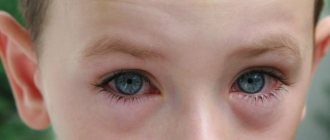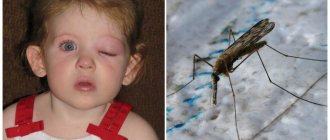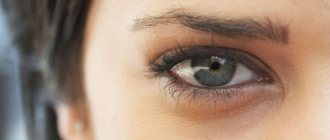Eye diseases are functional and organic lesions of the human visual analyzer. They limit the ability to see and affect the adnexal ocular apparatus. There are quite a few eye diseases, they are quite extensive.
The eyes are the most sensitive and delicate organ in the human body. And therefore they react to any irritant with itching and unattractive swelling of the eyelids.
Sometimes it is enough to simply eliminate the irritant, and the obvious discomfort goes away. But often, when your eyes itch and become swollen, you can confidently assume that the person has health problems.
Main reasons
Eyes itchy and swollen very often not for nothing, but as a result of the destructive action of some irritant.
The main reasons for this:
- Foreign bodies getting into the mucous membrane of the eye;
- Inflammatory processes;
- Infectious diseases;
- Environmental exposure;
- Ophthalmological diseases;
- Use of low-quality cosmetics;
- Genetic predisposition;
- Bad habits;
- Entry of pathogenic bacteria into the body;
- Long, thoughtless stay behind the monitor;
- Taking certain medications;
- Improper wearing of contact lenses;
- Insect bite;
- Allergic reaction;
- Worm infestation;
- Healing and therefore itchy wounds;
- Blockage or disease of the tear duct;
- Somatic pathologies: congenital and acquired;
- Chronic fatigue, stressful situations.
The main thing is not to ignore these symptoms, but to visit an ophthalmologist, find out the exact cause and carry out the necessary treatment or get advice.
Itching in the corners of the eyes
The appearance of such symptoms indicates various diseases of the organs of vision.
However, in some cases, itching does not indicate the presence of pathologies. There are situations when discomfort is caused by overwork. Drops with a moisturizing effect help to cope with visual fatigue.
Why do the corners of my eyes and nose itch? The following conditions may be the causes:
- Inflammation of the connective membrane of the organs of vision. Conjunctivitis is divided into several types. They can be bacterial, herpes, viral, or result from an allergic reaction. If symptoms of the disease appear, you should consult an ophthalmologist.
- Demodecosis. If the eye itches in the corner near the nose, the cause may be a pathology caused by mites. These insects infect the skin and cause an itching sensation. Demodicosis often indicates a deterioration in the functioning of the immune system and the presence of other ailments. Therefore, when its signs appear, you need to undergo a comprehensive examination.
- Entry of a foreign object into the visual area. In this case, you should also contact a specialist.
Allergic reaction
When your eyes itch and suddenly become swollen, it becomes clear that this could very well be a symptom of an allergy. Or more precisely, allergic conjunctivitis.
There are many allergens, let’s name the leading reasons why eyes swell and itch:
- Pollen of wild and domestic flowers and plants;
- Dust - street, industrial, home;
- Wool and fluff of domestic animals;
- Household chemicals and cosmetics;
- Certain medications;
- Many food products;
- Poplar fluff;
- Mold.
In addition to itchy and swollen eyes, the following symptoms are observed during an allergic reaction:
- Runny nose;
- Inflammation of the conjunctiva;
- Cough;
- Itching;
- Sneezing;
- lacrimation;
- “Glass-like” swelling of the mucous membrane;
- Blistering rashes on the skin, mucous membranes;
- Labored breathing;
- Papillary growths on the conjunctiva of the eyelids;
- Photophobia.
Causes of itchy eyes
The causes of allergies can be very different, including pollen from plants during their active flowering, and household dust or pet dander. Women's eyes may itch due to allergies to cosmetics, especially low quality ones.
The cause may also be chemicals used at home or at work. Redness and itching of the eyes often occurs while taking certain medications. Allergens that are in the air settle on the face and mucous membranes and cause irritation.
There are other causes of allergies, sometimes the disease manifests itself due to contact with direct sunlight, damage to the mucous membrane of the eyes, or after eating foods that have allergenic properties.
Infectious diseases
It is very important for infectious eye diseases to quickly respond to the first manifestations. Because if the infection spreads deep into the tissues, then damage to the optic nerve or retina will be difficult to avoid.
This can lead to vision deterioration and even loss.
Infectious diseases are caused by viruses, bacteria, and certain pollutants such as chlorinated water and dirty hands.
The following diseases are caused by:
- Herpes virus;
- Ulcerative blepharitis;
- Conjunctivitis;
- Epidemic keratoconjunctivitis;
- Purulent eye infection;
- Infectious keratitis;
- Greivis' disease.
Main symptoms of eye infections:
- The eyes are itchy and slightly swollen;
- Severe redness of the whites of the eye;
- Purulent discharge;
- lacrimation;
- Crusts form on the eyelid itself, in the corners of the eyes;
- Persistent feeling of sand and burning in the eyes.
Conjunctivitis
Conjunctivitis is the most common disease today, in which a person’s eyes always itch and become swollen. The mucous membranes of the eyelids and sometimes the eyeball become inflamed.
There are 3 types of conjunctivitis:
- Viral;
- Bacterial;
- Allergic.
The infection is provoked by:
- Adenoviruses (herpes, influenza viruses, ARVI);
- Chlamydia;
- Mushrooms;
- Bacteria.
Symptoms of conjunctivitis:
- Eyes become very itchy and swollen;
- Redness;
- lacrimation;
- Photophobia;
- Purulent discharge (usually characteristic of the bacterial form);
- Possible low-grade fever;
- Enlarged lymph nodes;
- Decreased visual acuity.
The disease most often affects both eyes at once. However, sometimes the inflammatory response is expressed differently in each eye.
Blepharitis
With blepharitis, the eyes become itchy and swollen, and inflammation of the edges of the eyelids also occurs. It manifests itself in such forms as allergic, ulcerative, seborrheic and demodectic.
Causes of the disease:
- Various lesions of the eyelids, for example, mites, fungi, bacteria;
- Infectious diseases;
- Diabetes;
- Anemia and lack of vitamins;
- Dental disease;
- Tuberculosis;
- Allergic diseases;
- Various diseases of the digestive tract;
- Farsightedness and astigmatism;
- Dry eye syndrome.
General symptoms:
- The eyes are a little itchy and swollen, and there may be watery eyes;
- Scales and crusts form on the skin of the eyelids;
- Slight burning sensation;
- The eyes quickly get tired and stick together;
- Fear of bright light;
- Loss and sticking of eyelashes.
In the morning hours, the patient's symptoms are clearly expressed in a large accumulation of pus, gluing the eyelids. The only way to help open the eyelids is by rinsing.
Barley
It happens when the hair follicle or its sebaceous gland becomes inflamed.
Barley appears for the following reasons:
- Staphylococcus;
- Streptococcus;
- Diabetes;
- Chronic sinusitis;
- Gastrointestinal diseases;
- Parasitic infestations;
- Untreated teeth;
- Decreased local immunity.
Stye always begins with a slight redness in the eye, and then the following symptoms are observed:
- The eyes itch and swell especially quickly when scratched;
- Pain on palpation;
- There is a general feeling of poor health.
Depending on the number of ulcers, stye on the eye can be single or multiple, occurring in one or both eyes. Multiple recurrent styes occur when infection spreads from one hair follicle to another and are usually observed in debilitated patients.
Dacryocystitis
With dacryocystitis, the lacrimal sac becomes inflamed, the eyes itch and swell. It is predominantly a female disease and quite rare.
The cause of inflammation is a violation of the natural outflow of tears due to:
- Swelling of the nasal mucosa;
- Inflammation.
The tear accumulates in the lacrimal sac, and creates suitable conditions there for the development of various infections and the addition of pus.
Dacryocystitis manifests itself as follows::
- Narrowing of the palpebral fissure;
- Severe lacrimation;
- The eyes are itchy and unsightly, especially for a woman they become swollen;
- There is severe redness;
- Acute pain;
- From the inner corner of the palpebral fissure, pus may be discharged;
- Insurmountable weakness;
- Headache;
- Increased body temperature;
- A swelling appears above the lacrimal sac.
According to clinical forms, chronic, acute dacryocystitis and dacryocystitis of newborns are distinguished. Depending on the etiology, dacryocystitis can be viral, bacterial, chlamydial, parasitic, or post-traumatic.
Diseases as a cause of itching and tearfulness
What diseases can lead to excessive watery eyes and itching? Let's talk about the most common pathologies. First, let's discuss eye allergies.
Allergy to the eyes
An allergy is an increased reaction of the body to the action of any irritant. It can appear in both children and adults. The skin and mucous membranes are most vulnerable to this disease, and the organs of vision are often affected. This is because our eyes are directly exposed to irritants in the air. Anything can act as an allergen:
- animal hair;
- house dust;
- pollen;
- decorative cosmetics;
- medications;
- contact lenses and care products for them;
- chemical substances;
- small foreign bodies;
- mold spores.
If your eyes are red, itchy, and watery, it may be an allergic reaction.
Typical signs of allergic eye damage are the following patient complaints:
- photosensitivity;
- tears “flow like a river”;
- dry eyes;
- itching and burning in the corners of the eyes;
- feeling of sand;
- redness and swelling;
- mucous discharge.
Eye allergies can be seasonal or year-round. Seasonal allergies typically appear in spring and summer. Most often, plant pollen acts as an allergen.
Important! The wind can carry pollen over a distance of up to 300 m, so it is almost impossible to independently determine what exactly caused the allergy.
For hay fever or seasonal conjunctivitis, bilateral damage to the organs of vision is typical. The disease causes the appearance of copious mucous discharge. If the eyes fester, this indicates a bacterial infection. Along with ophthalmological symptoms, rhinitis, nasal congestion, sore throat, and runny nose may appear. The disease lasts from several days to two weeks.
How to treat eye allergies? Antihistamines will help relieve unpleasant allergy symptoms for a while. But it is worth noting that such drugs do not eliminate the cause of the increased reaction. Histamine is a substance that provokes the development of symptoms in an allergic reaction. Its receptors are also located on the mucous membrane of the eye.
If you want to completely get rid of the disease, you first need to identify the irritating allergen and then eliminate contact with it. Otherwise, no matter how many antihistamines you use, the disease will return again and again.
What to do with seasonal conjunctivitis? Try to avoid contact with the allergen
If the cause of your allergy is pollen, then you should not go outside in the morning, since its concentration in the air is at its highest. After rain, allergy sufferers feel much better, this is due to the fact that water brings pollen to the ground.
It is also worth noting that the tissue of the lacrimal glands takes quite a long time to recover. In order to facilitate this process, experts prescribe moisturizing drops. In severe cases, the use of antibacterial and hormonal agents may be required.
Demodicosis
Demodicosis is a disease caused by mites of the genus Demodex. These microorganisms belong to opportunistic microflora, which means that in small quantities they can live on the human body without causing disease. When the immune system is weakened, ticks begin to actively multiply, causing a pathological process. A variety of reasons can cause a disorder of the immune system:
- diseases of the nervous system;
- vascular pathologies;
- hormonal imbalance;
- endocrine disorders;
- digestive disorders.
Demodex mites can live on eyelashes in small numbers without causing disease
Mites themselves do not pose a threat to humans, but their waste products are strong allergens. Demodex mites can cause rosacea, seborrhea, blepharitis, and blepharoconjunctivitis. Males die immediately after fertilization, and females gnaw through the tunnels and lay eggs in them.
Eyelash mites can live for a long time in cosmetic creams, Vaseline, and vegetable oil. Tar has a detrimental effect on pathogenic microorganisms.
Demodicosis manifests itself in the form of the following symptoms:
- severe itching, swelling and peeling of the eyelids;
- constant hyperemia of the edges of the eyelids;
- eyelash loss;
- the appearance of mucous discharge;
- dry eyes;
- fast fatiguability;
- inflammatory processes.
Important! Demodex mites are difficult to remove, sometimes treatment lasts up to six months.
Demodectic mange will not go away on its own; it requires complex treatment.
Drug treatment is not enough. Be sure to disinfect bedding, personal items, and hygiene items. You should also reconsider your diet and exclude spicy, salty, smoked, and alcohol.
Herpetic lesion
Ophthalmoherpes is a dangerous disease that affects the cornea and leads to vision impairment. In advanced cases, the infection affects the deep tissues of the eye and leads to complete blindness.
Herpes of the eye can develop for a variety of reasons, including:
- weakened immune system;
- psycho-emotional experiences;
- eye injuries;
- pregnancy period;
- eye infections;
- exposure to low or high temperatures;
- taking certain medications.
You can become infected with herpes by sharing household items.
A viral infection can enter the body through the oral cavity, as well as the respiratory and genital tract. Herpes in newborns can be the result of infection during passage through the birth canal.
Ocular herpes is characterized by the following symptoms:
- hyperemia of the eyeball;
- profuse lacrimation;
- itching and tingling of the eyelid;
- pain and foreign body sensation;
- the appearance of watery blisters, in place of which crusts later form;
- photophobia;
- blurred vision;
- eyelid twitching;
- narrowing of the palpebral fissure;
- headache, weakness, slight increase in body temperature.
To combat the causative agent of the disease, antiviral drugs are prescribed:
- Acyclovir ointment and tablets for oral administration;
- Vidarabine gel for treating the conjunctiva;
- eye drops Oftalmoferon, Oftan-IDU, Idoxuridine;
- ointments are placed behind the eyelid or applied directly to the skin of the eyelids: Tebrofen, Riodoxol, Bonafton.
Keratitis
Keratitis is an inflammatory disease of the cornea of the eye. The disease has an infectious and traumatic nature of its occurrence. Keratitis is characterized by the following symptoms:
- eye pain;
- feeling of sand in the eyes;
- profuse lacrimation;
- increased sensitivity to light;
- blurred vision;
- difficulty opening eyelids;
- headaches from the affected eye.
Keratitis is an inflammation of the cornea
The disease can be caused by viruses, bacteria, and fungi. Treatment directly depends on the causative agent of keratitis. What helps with a bacterial infection will be completely ineffective with a viral pathology.
For viral keratitis, eye drops are prescribed: Oftalmoferon, Actipol or Poludan, as well as ointments - Acyclovir, Zovirax. For bacterial inflammation of the cornea, antibiotics are prescribed, for example, Floxal. If keratitis is of an allergic nature, then you cannot do without antihistamines and hormonal agents.
Ophthalmic diseases
The number of eye diseases is very large. There are hundreds of diseases that cause itchy and swollen eyes. According to statistics, more than half of the world's inhabitants have ophthalmological problems.
Below we will describe the most common ones, their symptoms, and causes.
Eyesore
A cataract or leukoma is characterized only by clouding of the cornea. The main cause of cataract is cicatricial changes on the cornea of the eye, of various origins.
When scarring occurs, the cornea loses its natural transparency and light transmittance over time. And it acquires a rather specific and unpleasant porcelain-white color. But over time, the leukoma will turn yellow.
Causes of leukoma:
- Injuries;
- Congenital anomalies;
- Keratitis;
- Trachoma or conjunctival lesions.
Characteristic symptoms:
- Veil before the eyes;
- Pain in the eyes;
- The eyes become itchy and even swollen;
- Fear of bright and even daylight;
- lacrimation;
- Persistent feeling of a foreign body.
There are two types of leukoma: acquired and congenital. The first type is much more common in patients.
Cataract
With cataracts, the lens of the eye becomes completely or partially cloudy. It is naturally transparent and acts as a kind of lens. Which refracts light rays and opens access to the retina.
But with cataracts, the lens ceases to perform its function and transmit light. And a person’s vision deteriorates, and then it is completely lost.
There is age-related cataract, it usually develops when the composition of the lens changes. This is facilitated by age-related, irreversible processes.
Some possible reasons:
- Many endocrine disorders - hyperthyroidism, diabetes mellitus;
- Active smoking;
- Long-term use of certain unsafe medications.
Signs and symptoms:
- A person sees objects through a veil or heavily fogged glass;
- Doubling of objects;
- Eyes itchy and swollen;
- Deterioration of night vision;
- Inability to look at bright lights;
- Difficulties in selecting glasses;
- Reduced color perception.
Conservative therapy is used to slow the progression of cataracts. Cataract removal is performed by microsurgical intervention with the replacement of the lens with an intraocular lens.
Glaucoma
Glaucoma inevitably leads to blindness over time. Often increased intraocular pressure destroys the retina. Then the optic nerve completely atrophies.
And visual signals can no longer fully reach the brain. Therefore, peripheral vision is also impaired, the visibility zone is narrowed to the limit, the eyes itch and swell.
Risk groups include:
- Elderly people from 60 years of age and above;
- With the upper limit of intraocular pressure;
- Eye injuries, operations, inflammatory processes;
- Persons with a high degree of farsightedness or myopia;
- High or low blood pressure;
- Low or high eye pressure;
- Various chronic diseases: nervous disorders, vascular;
- Patients with glaucoma;
- Incorrect or prolonged use of hormonal drugs.
The main symptoms of glaucoma are:
- Narrowing of the field of view;
- The eyes are itchy and very swollen;
- The appearance of flies or “mesh” before the eyes;
- Deterioration of vision, especially at night;
- There is a deceptive feeling of eye moistening;
- Minor pain bothers me.
According to statistics, about 70 million people suffer from glaucoma in the world, and a million of them live in Russia. Experts predict that 80 million people will be affected by this disease in 2020.
Ophthalmic rosacea
Ophthalmic rosacea is a dangerous chronic skin disease. Localized in the face area, closer to the eyes, in the form of erythema. Bilateral damage occurs, the eyelids and cornea are affected.
Causal factors include:
- Drinking alcohol, smoking;
- Temperature changes;
- Exposure to ultraviolet radiation;
- Gastrointestinal pathology.
Symptoms of ophthalmic rosacea:
- Eye irritation
- Eyes itchy and swollen;
- Burning sensation, possible hyperemia;
- Noticeable decrease in vision.
Manifestations of ocular rosacea range from minor eye irritation and dryness, blurred vision, to severe ocular surface disorders, including keratitis.
Electroophthalmia
Electroophthalmia is when the eyes are affected by ultraviolet rays. Often the source of radiation is a welding arc.
Symptoms of electroophthalmia:
- Eyes become itchy, red and swollen;
- Clouding of the corneal epithelium;
- Tears are flowing;
- Facial spasm is observed;
- Persistent feeling of sand in the eyes.
With a mild course of electroophthalmia, redness of the conjunctiva, eyeball, vaults of the eye, and swelling of the eyelids develop. A severe form of the disease leads to clouding of the cornea and the appearance of superficial blisters.
Eyes become swollen and itchy due to mites
This is called demodicosis of the eyes and is accompanied by diseases of the organ of vision. That's why my eyes itch all the time and swell. The disease is provoked by a well-known arachnid, subcutaneous parasitic mite, not exceeding 0.5 mm in size.
The spider affects glands such as sweat and sebaceous glands - this provokes the appearance of various inflammatory processes in the body.
Demodicosis can be triggered by various causative factors:
- Exposure to high temperatures, for example, excessive solar radiation, a regular bath, sauna;
- Immunity declines;
- Surgery on the eye;
- Liver diseases;
- Metabolic disease;
- Nervous disorders;
- Visit to the hotel;
- Using someone else's cosmetics.
When the mite is at the peak of its activity, a special yellow secretion is released from the eye. Gradually, small pustules appear near the bulb - vesicles that have purulent contents.
Wearing contact lenses
With poor vision, many people prefer lenses to glasses. This is convenient, of course, and invisible to others.
During adaptation, you will feel discomfort, your eyes will itch and swell. When wearing contact lenses for a long time, you can easily damage the delicate mucous membrane.
When infected, the eyes will begin to:
- itch;
- The whites will turn red;
- Discharge appears;
- Watery eyes appear;
- Pain and feeling of a foreign object in the eye.
You need to properly care for your lenses:
- Follow the replacement schedule;
- Wash and disinfect in a timely manner;
- Put on only with clean hands.
Spending prolonged periods of time in front of a computer or television screen
When you spend a long time at the computer, your eyes quickly get tired, itchy, swollen, and can become inflamed. The mucous membrane is naturally protected by the tear film.
But with reduced secretion, the film quickly becomes thinner and the person involuntarily begins to experience discomfort:
- Slight burning sensation;
- Visual acuity decreases;
- Eye diseases appear;
- Eyes itchy and swollen in the morning;
- A small veil appears before the eyes;
- A headache begins.
To avoid the unpleasant consequences of being at the computer, you need to take hourly breaks.
In moments of rest:
- Do eye exercises, for example, blink intensely and move them in different directions;
- Instill “artificial” tears, this is an over-the-counter drug.
Causes of eye discomfort
Similar symptoms: itching, redness and swelling of the eyelids have a large number of diseases, both allergic and ophthalmological in nature. Different groups of drugs are used to treat them. Also, depending on the cause of its occurrence, irritation can be localized both on the mucous membrane itself and on the eyelids. To choose the right treatment tactics, it is important to understand why your eyes itch and swelling appears.
Allergy
When discomfort occurs in the eye area, the first thing that comes to mind is allergies, or more precisely, allergic conjunctivitis. Especially if this condition is accompanied by sneezing, nasopharyngeal congestion, lacrimation and redness. Spring and early summer are the traditional season of exacerbation of allergic reactions in people. During this period, many trees and herbs begin to bloom, which become a provoking factor for allergy sufferers. When an allergen enters the body, the process of producing protective substances – “mediators” – starts. The most common of which is histamine, which causes hyperemia, increased lacrimation and swelling.
The leaders in the list of allergens are:
- Poplar fluff and plant pollen during the flowering period.
- Wool, saliva and waste products of pets.
- Bird feathers.
- Household dust, smoke.
- Decorative cosmetics.
- Detergents and household chemicals.
- Medicines.
- Glue for artificial eyelashes.
- Food.
Infectious diseases
Stye on an adult's eyelid
Infection is one of the most common causes of itching and swelling of the eyelids. If the itching is most intense in the corners of the eyes near the bridge of the nose, then the most likely cause of this condition is conjunctivitis. The causes of this inflammatory process are fungi, chlamydia, viruses and bacteria. In the acute stage, pus is released and body temperature rises. In addition to a deterioration in a person’s general well-being, vision loss may occur.
Blepharitis is also characterized by inflammation at the edge of the eyelid. As a rule, this disease occurs against the background of decreased immunity and can be of an allergic, acne, ulcerative or fungal nature.
Barley is on the list of leaders in infectious diseases. Despite the fact that it is not so dangerous for humans, the treatment process is very long and unpleasant. The cause of inflammation of the sebaceous gland around the hair follicle can be the ingress of dust or dirt, as well as a sharp change in temperature (cold air from an air conditioner or a draft in transport).
Ophthalmic diseases
A large number of ophthalmic diseases cause severe itching of the eyes and swelling of the eyelids. If this is accompanied by increased pressure inside the eye, then this is a reason to seek help from an ophthalmologist as soon as possible. When visiting a specialist, the fundus of the eye must be examined and the intraocular pressure measured, after which an accurate diagnosis can be established.
The following congenital and acquired diseases have similar symptoms:
- Glaucoma occurs due to impaired fluid circulation and deterioration of its outflow. It can be caused by disorders of the normal functioning of blood vessels and nerves. When fluid is retained in the eyes, pressure increases. In the early stages, glaucoma is characterized by the appearance of multi-colored circles when a person looks at a light source. The sharpness of vision often deteriorates.
- Cataracts appear when the supply to the lens of the eye is disrupted, causing it to become cloudy. Cataracts can develop as a concomitant disease with diabetes, due to eye injury, or when working at extremely high temperatures for a long time.
- An eyesore (leukoma) is often accompanied by itching and swelling of the eyelids. This disease can be either congenital or acquired, for example, after an injury or an inflammatory process.
To prescribe treatment, it is necessary to contact an ophthalmologist as soon as possible so that the disease does not progress to serious stages, which are characterized by irreversible changes in the cornea and even loss of vision.
Other causes of itching and swelling of the eyelids
A person may also experience discomfort in the eyelid area in the following cases: disruption of the normal functioning of the gastrointestinal tract, diabetes mellitus, disruptions in metabolic processes, liver disease, the presence of parasites, smoking, alcohol consumption, sudden changes in ambient temperature, chronic lack of sleep, incorrectly selected glasses or lenses, as well as tattooing.
Particular attention should be paid to wearing lenses and the “office or dry eye” syndrome, which very often occurs during prolonged work at the computer. During the adaptation period, contact lenses may cause some discomfort and a foreign body sensation. If irritation and redness do not go away for a long time, you may have to completely abandon this method of vision correction. But first, you can try changing the type and brand of lenses, as well as storage liquids.
When working at a computer for a long time, your eyes can become inflamed from extreme strain. The mucous membrane of the eye in a normal healthy state is protected by a tear film. But with a decrease in secretion or an increase in evaporation, this film becomes thinner. The person begins to feel a burning sensation, discomfort, and in some cases visual acuity decreases. To solve this problem, it is recommended to take breaks when working at the monitor. In moments of rest, you need to blink intensively to restore the level of moisture in the mucous membrane or drip special drops - carbohydrate polymers - “artificial” tears. Dry eye syndrome often occurs when living in a hot climate, as well as in smokers.
Other diseases that make the eyes itchy and swollen
Other ophthalmic diseases that cause itchy and swollen eyes:
- Amblyopia occurs when one eye dominates the other. The functioning of the brain and organ of vision is impaired;
- Retinal dystrophy is a severe damage to the eyeball, i.e., death of the retina;
- Astigmatism is a pathology of the lens or cornea;
- Presbyopia - age-related farsightedness;
- Colorblindness is the inability to distinguish colors;
- Keratoconus - leads to thinning of the cornea;
- Myopia - inability to see objects at a distance;
- Farsightedness is the inability to focus on nearby objects.
Eyes become itchy and swollen in children
If you notice that your child's eyes are itchy and swollen, be sure to take action. Because this is an alarming symptom and a consultation with a pediatrician is necessary here.
Often the doctor quickly removes the discomfort, and everything returns to normal. But in some cases, emergency and even surgical care will be required.
Here is a list of the main reasons why the eyes itch and swell in children:
- The child cried for a long time and rubbed his eyes;
- Due to the bite of a mosquito , midge and other insects;
- Allergic reaction of the body , in which nasal congestion does not go away;
- There may be a foreign body in the eye , for example, a speck of dust or a midge;
- Due to simple overvoltage . The following can have a negative impact: TV, computer, gadgets, school studies. You need to teach your children to take at least short breaks on time and give some rest to their eyes;
- Barley is a purulent inflammation, the whole eye can swell, the child actively scratches the eyes, but they do not redden much;
- Congenital obstruction of the lacrimal canal - the corners of the eyes may become very itchy and swollen in infants. Because the mucous membrane dries out;
- Conjunctivitis can be of any origin, the causes of its occurrence are different: fungi, viruses, various bacteria. With conjunctivitis, the eyes are especially itchy and even swollen;
- During wound healing . The child’s body produces a special healing substance that provokes such symptoms;
- Abscesses of the eyelid and lacrimal sac lead to the accumulation of purulent masses in the tissues, the eyes quickly swell and constantly itch. Pus is formed during the development of many ophthalmological diseases or untreated sinus diseases (infectious).
Symptoms
Allergic eye swelling has characteristic symptoms. It can intensify in the absence of timely assistance and complications of the disease.
- No pain. An allergic reaction is not accompanied by injury or the formation of wounds, so the person experiences only discomfort.
- Constant itching, worse in the evening and at night.
- Redness of the skin, paleness or even cyanosis may be observed, this depends on the individual course of the condition that has arisen.
- Edema appears in one, less often in two eyes.
- Allergic edema provokes photophobia, increased lacrimation, complicated by a runny nose.
- There is a burning sensation in the eyelid area.
- The whites of the eyes and the surrounding skin turn red.
- The swelling spreads, causing puffiness under the eyes.
- The swelling develops rapidly, but after stopping contact with the allergen it can completely disappear within 24 hours.
- In children and adults with increased sensitivity to allergies, general weakness, drowsiness, periodic or constant chills are observed.
Pain can occur from an insect bite in the eye area or from self-scratching in an attempt to relieve the burning sensation.
Diagnostics
If your eyes are itchy and swollen. You should immediately contact an ophthalmologist. This will help avoid serious complications and even loss of vision.
The doctor will take the following measures:
- Conduct an examination and test your vision;
- Examines discharge from the eyes;
- Determine whether there is an allergy;
- Eliminates infectious origin of ailments;
- Assess the condition of the fundus;
- Conducts pupillary reaction to light;
- Prescribe treatment if necessary and determine the date of the next appointment.
Treatment
In order to prescribe treatment that will be able to help eliminate the disease, it is necessary to diagnose the patient and find out which type of allergy caused certain symptoms. Naturally, with any manifestation of an allergic reaction in the eyes, you must consult a doctor to receive first aid. After this, doctors will talk in detail about what to do if you have eye allergies and how to prevent the appearance of new symptoms.
To treat an allergic reaction, antihistamines are prescribed, as well as drops that will help cope with itchy eyes.
It often happens that infectious inflammation is associated with allergic inflammation. In such cases, antibacterial therapy is prescribed in the form of ointments or tablets.
At the first manifestations of the disease, you should consult a doctor and under no circumstances decide anything on your own; what to do can only be determined by a doctor. And if quality treatment is not started in time, an allergic reaction can affect the optic nerve and completely deprive one or both eyes of vision.
Treatment methods
Let's look at methods of treating the main diseases that cause itchy and swollen eyes.
Treatment of an allergic reaction
The main method of treatment is the use of medications.
Two categories of drugs are used for treatment:
- Drugs that relieve symptoms;
- Drugs that eliminate the allergen.
The most popular drugs:
- Kromofarm - recommended for use in the form of drops. Apply four times a day, 1 or 2 drops. In rare cases, apply eight times. The main contraindications are children under five years of age, breastfeeding, as well as pregnancy and hypersensitivity. The cost in pharmacies ranges from 100 to 300 rubles ;
- Visin Alergy is an effective drug that can be administered both intranasally and conjunctivally. It is recommended to administer the drug intranasally. Drops can be used from the age of six. Before use, you must thoroughly clean your nasal passages. It is necessary to do two inhalations twice a day. Sometimes prescribed four times a day. Contraindications: children under six years of age, breastfeeding and pregnancy, as well as hypersensitivity. The cost of the drops is 300 rubles .
Kromofarm Vizin Alergy
Treatment of unpleasant symptoms when wearing contact lenses
If your eyes become swollen and itchy, then you need to consult an ophthalmologist. The doctor will prescribe other lenses. And the doctor may also prescribe medications to eliminate discomfort - lubricating and moisturizing drops.
The most popular drug is Hilo-Komod drops.
Place one drop of the drug in each eye three times a day.
If necessary, increase the frequency of use.
Hilo-Komod drops are prescribed from the age of 18.
The cost is 700 rubles .
Treatment for cataracts
Cataracts are a dangerous eye disease. Sometimes surgery is required to treat cataracts. Cataracts can lead to complete blindness. You cannot treat this disease on your own. Only a doctor can prescribe drugs to treat such a disease.
The most commonly prescribed drugs are:
- Quinax eye drops - drops are used 3 times a day, two drops in one eye. Quinax should not be used by children, during pregnancy, with sensitivity to chemicals or while breastfeeding. The cost varies from 700 to 800 rubles ;
- Oftan Katahrom - the drug is used three times a day, you need to instill 1-2 drops. Contraindications: pregnancy, breastfeeding, individual sensitivity to any components. Can be used from 18 years of age. The average cost is 250 rubles .
Quinax Oftan Katahrom
Eye treatment for prolonged screen time
Most prescribed drugs:
- Systane drops - used 1-3 times a day, one or two drops in each eye. Contraindications: individual intolerance, as well as pregnancy. Cannot be prescribed to children. The cost is 400 rubles ;
- Oftagel - apply 1-4 times a day, one drop. It is not recommended for children or those with sensitivity to the components of the drops. Cost 250 rubles .
Systane Oftagel
Treatment for the appearance of barley
Most prescribed drugs:
- Albucid eye drops - apply 2-3 drops into the affected eye 5-6 times. Contraindications: hypersensitivity to components and pregnancy. Cannot be used by children under three years of age. Average cost 80 rubles ;
- Hydrocortisone - ointment is used before bedtime, the product is placed in the conjunctival cavity behind the lower eyelid. Cannot be used by children under two years of age. The average cost is 90 rubles .
Albucid Hydrocortisone
Treatment for glaucoma
Glaucoma is a chronic disease in which the optic nerve atrophies.
Therefore, instillation of anti-glaucoma drops, for example, Timolol, is indicated.
You need to drip 2 times a day, one drop. Timolol should not be used by children under three years of age.
Contraindications: sinoatrial blockade, lactation, bronchial asthma, dystrophic diseases.
The average cost is 60 rubles .
Treatment for ophthalmic rosacea
For drug treatment, Tetracycline ointment is used.
Apply 3-4 times a day. The course of treatment lasts 5-7 days.
Contraindications include pregnancy, lactation, kidney and liver dysfunction, and various fungal diseases.
Prohibited for use by children under eight years of age.
The average cost is 150 rubles .
Treatment for electroophthalmia
- Cyclomed - cycloplegic drops, which are instilled 1 drop up to 4 times a day. It is permissible for children to use the drug, but only with a doctor’s prescription. Contraindications: high sensitivity to components, glaucoma, pregnancy, intestinal obstruction. Average cost 600 rubles ;
- Tobradex - antibiotic drops are suitable for various infections. Application: instill every 2 hours for the first 3 days, then 1-2 drops every 4-5 hours, treatment for no more than 8 days. It can be prescribed even to newborn children. Contraindications: fungal diseases, microbacterial infections, pregnancy and viral conjunctivitis. The average cost is 250 rubles .
Cyclomed Tobradex
What to do?
Washing your eyesight will help relieve symptoms.
If the organs of vision begin to itch very often due to allergies, then to prevent the development of the disease it is necessary to wash the eyes 2 times a day and try not to touch the visual organs with dirty hands. Also, you should not use expired cosmetics. When working in dusty conditions, protect your eyes with goggles. To reduce the number of allergens, the room is wet cleaned every day, and a respirator is used when working with chemicals. If infectious diseases of the optical system occur, it is necessary to treat them and take vitamin complexes to increase immunity. Spend more time walking in the fresh air.
How to treat with medications?
Treatment of any type of conjunctivitis caused by allergies includes the following principles:
- limiting the patient’s contact with allergens;
- drug therapy;
- increasing immunity.
For drug therapy of all types of conjunctivitis, the following drugs are used:
Tablet antihistamines can be taken for up to a week.
- Antihistamines. Used internally for more serious types of allergic reactions. The tablets are taken in a course of 3-6 days.
- Cream and ointment. Corticosteroid (hormonal) medicine is used only for complicated allergic reactions, as it can cause atrophy of the ocular membrane. If an infection is added to the allergy, then antibacterial agents are used.
- Eye drops: vasoconstrictor;
- antihistamines;
- anti-inflammatory.
The table shows the most popular pharmaceutical drugs for the treatment of allergies:
| Type of medicine | Name |
| Antihistamines | "Claritin" |
| "Tavegil" | |
| "Zyrtec" | |
| "Loratadine" | |
| Creams and ointments | "Celestoderm" |
| "Advantam" | |
| "Erythromycin" | |
| "Gistan" | |
| Eye drops | "Okumetil" |
| "Allergocil" | |
| "Opticrom" | |
| "Vizin" | |
| Multivitamins | "Duovit" |
| "Supradin" | |
| "Aevit" | |
| "Alphabet" |
"Okumetil"
Okumetil will quickly solve the patient’s problem.
A combined drug in the form of drops that relieves eye itching very well. Also used for different types of conjunctivitis. Sometimes after instillation there is a feeling of burning and stinging. Contraindications:
- glaucoma;
- epilepsy;
- diabetes;
- pregnancy;
- bronchial asthma;
- arterial hypertension.
"Diazolin"
Antihistamine tablets are also used to relieve itchy eyes for eczema, hay fever and insect bites. After taking the pills, sometimes there is heartburn, nausea, dizziness, drowsiness, and urinary retention. Contraindications:
- arrhythmia;
- inflammation of the gastrointestinal tract;
- epilepsy.
Treatment at home with folk remedies
Of course, you can treat your eyes at home with popular folk remedies, but you should not believe only in the magical power of folk recipes and abandon modern medicine.
Do not forget to make sure that you are not allergic to the product used or its components.
Let's consider treatment with folk remedies.
Treatment of eye pressure
Aloe flower will help treat eye pressure.
Directions for preparation and use:
- Tear aloe (2 leaves) by hand and pour 250 ml of boiling water;
- Boil for one minute;
- Cool and strain;
- Rinse your eyes with this decoction up to 5 times a day for two weeks;
- Then you need to take a break for half a month and undergo treatment again;
- Take 3 courses and there will be no trace of the disease;
- This remedy has no contraindications;
- For children from 6 years of age.
Treatment of demodicosis of the eyelids
For demodicosis of the eyelids, it is worth mixing:
- 2 g combustible sulfur;
- 2 tbsp. spoons of birch tar;
- 2 tbsp. spoons of interior lard (be sure to melt).
Directions for preparation and use:
- Mix all ingredients;
- Put on fire and boil for 2 minutes;
- When it cools down a little, pour into a jar;
- Be sure to lubricate your eyelids with the resulting mixture at night;
- In the morning, wash off the residue;
- The course of application is at least 2 months;
- Use with caution for people with sensitive skin and a predisposition to allergies;
- Suitable for use from 15 years of age.
Treatment of conjunctivitis
Conjunctivitis is treated with herbal infusions.
Take 1 tbsp. spoons of herbs, necessarily chopped:
- snapdragon;
- marshmallow root;
- black nightshade leaves.
Directions for preparation and use:
- Pour 0.5 liter of boiling water;
- Cover and leave until cool, filter;
- Instill 2 drops 1 time per day until healing.
An infusion of cornflowers also helps:
- Take 1 tbsp. spoon of flowers and pour 1 cup of boiling water;
- Wash the eyes with a slightly warm solution every morning for ten days;
- This remedy is very effective for conjunctivitis and also has no contraindications;
- It should not be used by young children without a doctor.
Treatment for the appearance of barley
Barley can be easily cured at home; use one of the methods described below. Moreover, they are harmless, and even small children can be treated with eggs. The first method can only treat adults.
The first way is to eat 4 dry baskets of tansy per day, washed down with plenty of water.
Second way:
- Boil the egg;
- Take out half of the white and apply it to the eye;
- Keep until it cools down.
Another effective way is to apply boiled flaxseed in a gauze bag to the barley.
Treatment for glaucoma
For glaucoma, flower pollen is a great help, which should be taken 15 g per day for a month.
Using a compress for treatment:
- Mix 2 tbsp. l. fresh nettle and 1 tsp. lily of the valley flowers;
- Pour 1 tbsp. water and leave for 8 hours;
- Add 0.5 tsp. soda, stir;
- Make compresses 2 times a day, for at least 10 minutes;
- Contraindicated for children and pregnant women.
Blueberries improve vision and prevent seizures. You can drink teas or eat fresh berries in unlimited quantities. It has absolutely no contraindications, and is especially useful for children and adults.
Prevention
The following simple tips will help you avoid dangerous situations:
- Do not touch your face with your hands, especially outside the home;
- Strictly observe the rules of personal hygiene;
- Visit an ophthalmologist regularly, especially after 40 years of age;
- Protect your eyes from adverse conditions (use glasses);
- Take breaks when working at the computer;
- Moisturize the mucous membrane with special drops;
- Eat properly;
- Use proven cosmetics;
- Drink at least 2 liters of water per day;
- With demodicosis, you need to sleep on pillows made of synthetic fillers;
- Play sports or at least take daily walks in the fresh air;
- Complete abstinence from alcohol, cigarettes and trips to the solarium.











